#st. heinrich
Explore tagged Tumblr posts
Text






The double tomb of Heinrich II (973-1024) and his consort Cunigunde from 1513. The side panels are decorated with scenes from their lives. Heinrich II was the Holy Roman Emperor from 1014 until his death. Empress Cunigunde buried her husband in Bamberg Cathedral. Heinrich II became St. Heinrich in 1147.
Cathedral of Bamberg.
Bamberg, Germany
Feb. 2023
#tombs of the dead and famous#holy roman emperor#holy roman empire#germany#deutschland#bamberg#st. heinrich#tomb#original photography#photography#taphophile#taphophilia#lensblr#photographers on tumblr#tombs#church#church photography#religious art#wanderingjana
18 notes
·
View notes
Text
Day 11: Sleeping on the job
So, here's the obvious thing: there is a patron saint of those who sleep on the job and her name is Pia.

If you're feeling tired but you still have work to do, you may pray to St. Pia. Rest assured that there is a parallel universe where Pia will fall asleep in your stead (because, yes, that is how patron saints work. they mess around in parallel universes, although they sometimes switch. After all these centuries, their desktops are a complete mess.)

However, this is not the only way in which St. Pia will work her miracles. If you actually have some time to spare, she may grant you a well advised power nap, so you may wake up refreshed and ready to go.
If you don't have time to spare though (because, let's say, an important meeting is due) St. Pia will appear and wake you up, so you may not miss your appointments.



So, when considering which patron saint to invoke next, keep in mind that there is St. Pia. (Luckily, she isn't picky when it comes to offers, so snacks, coffee, fast food - anything is fine).
Praise be. 🙏
#spatort#tatort saarbrücken#pia heinrich#patron saint of those being tired at work#30dtsc#30 day tatort saarbrücken challenge#30 days to spatort challenge#pls take this lightly#I come from a region where especially older folkes attribute a lot of weight to patron saints#and I grew up that way too - mining.. seafaring.. u name it#My grandparents would litterally be like Happy St. Barbara's Day#to me this always felt like a bunch of jinns or Pokemon haha#pls don't come to get me
16 notes
·
View notes
Text

Schweizerische Volksbank (1972-76) in St. Gallen, Switzerland, by Heinrich Graf
79 notes
·
View notes
Text
The Porcelain Maker by Sarah Freethy #ARCReview #NetGalley #BookReview #HistoricalFiction #WWII #StMartinsPress
In this debut novel, readers will learn about the creation of fine porcelain figurines in Germany during WWII under the direction of the leader of the SS, Heinrich Himmler. #ThePorcelainMaker #StMartinsPress #NetGalley #ARCReview #BookReview #WWIIFiction
Germany, 1929. At a festive gathering of young bohemians in Weimar, two young artists, Max, a skilled Jewish architect, and Bettina, a celebrated avant-garde painter, are drawn to each other and begin a whirlwind romance. Their respective talents transport them to the dazzling lights of Berlin, but this bright beginning is quickly dimmed by the rising threat of Nazism. Max is arrested and sent to…

View On WordPress
#Allach Porcelain#ARC Review#Book Review#Concentration Camp#Heinrich Himmler#Historical Fiction#Nazi Occupation#NetGalley#New Books#November 2023 Books#Sarah Freethy#Simon & Schuster#St. Martin&039;s Press#The Porcelain Maker#World War II#WWII
2 notes
·
View notes
Text








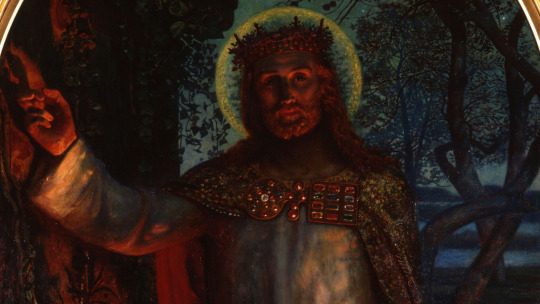







Jesus is queer and lives in Los Angeles
Footnote to Howl by Allen Ginsberg / Christ Displaying His Wounds by Giacomo Galli / 9-1-1 s2e16 "Bobby Begins Again" / 'stigmata' definition from Britannica / rumors about jesus by Keaton St. James
9-1-1 s2e12 "Chimney Begins" / The Entombment by Peter Paul Rubens (fragment) / trans jesus by Keaton St. James
9-1-1 s8e03 "Capsized" / a sticker I got with socio-cultural queer magazine in Poland / Bible / The Passion of the Christ (2004)
9-1-1 s7e03 "Capsized" / Jesus at the Gay Bar by Jay Humle
Hannibal s3e03 "Secondo" script / 9-1-1 s7e04 "Buck, Bothered and Bewildered" / The Light of the World (St Paul's Cathedral version) by William Holman Hunt (fragment) + its Wikipedia
9-1-1 s7e05 "You Don't Know Me" / the cover of Berek by Marcin Szczygielski / Angels in America by Tony Kushner / Most Sacred Heart of Jesus / Oh My Heart by R.E.M. / Pygmy Love Song by Francis Bebey
Christ in Gethsemane by Heinrich Hofmann / Goodtime Jesus by James Tate / 9-1-1 s7e05 "You Don't Know Me" / Gethsemane by Dry the River
9-1-1 s7e04 "Buck, Bothered and Bewildered" / Cristo de la Concordia (Christ of Peace) in Cochabamba, Bolivia / Personal Jesus by Depeche Mode / 9-1-1 s7e06 "There Goes the Groom" + Christ the Comforter by Carl Heinrich Bloch / God in Jeans by Ryan Beatty
9-1-1 s7e06 "There Goes the Groom" / Christ the Consoler by Kateryna Kariukova / Deathbed by Relient K
Hammer by Dry the River / 9-1-1 s7e04 "Buck, Bothered and Bewildered" / Bible / 9-1-1 s7e06 "There Goes the Groom" / November by Keaton St. James
Something That May Shock and Discredit You by Daniel Mallory Ortberg / 9-1-1 s7e05 "You Don't Know Me" / 9-1-1 s7e10 "All Fall Down" / Making Pies by Patty Griffin / Touch Me from Spring Awakening (with a comment from Genius.com) / Footnote to Howl by Allen Ginsberg
#tommy kinard#bucktommy#evan buck buckley#lou ferrigno jr#web weaving#parallels#keaton st james#bible#dry the river#angels in america#queer jesus#spring awakening#depeche mode#patty griffin#allen ginsberg#911 abc#hannibal#edit#(my stuff)#me: growing up in a very religious country didn't really affect me all that much#also me once i love a character: THIS BABY CAN FIT SO MUCH RELIGIOUS SYMBOLISM
204 notes
·
View notes
Photo
Einen frohen Georgstag an unsere österreichischen Follower

Heinrich Lefler (1863-1919), “Oesterreichische Monatsbilder”, 1900 Source
584 notes
·
View notes
Text

Cooling off. St Heinrich, Munich, Germany. 1950
Photo: Herbert List
101 notes
·
View notes
Note
what are some of your favorite portrayals (medieval or retellings it doesn't matter) or sir kay?
Hi anon! Why, I'm so glad you asked. I love Sir Kay in all his forms. :^) I'll write out a complete list of my favorite portrayals of him across the board from Medieval Literature to Modern retellings, movies, and TV shows, that way everyone can find what medium suits them best. Links to read and watch everything are provided.



Medieval
Cullhwch and Olwen
An obvious banger. Cai has his supernatural powers of growing as large as a tree, holding his breath for nine days, & "hot hands." He apparently uses this for blacksmithing. He & Bedwyr are inseparable.
The History of the King's of Britain by Geoffrey of Monmouth
Caius helps Arthur & Bedevere kill the giant of Mont St Michael. After Bedevere is slain in battle, Caius suffers a mortal wound while retrieving his body from the field.
Peredur, Perceval, & Parzival
Peredur/Perceval/Parzival breaking Cai/Kay’s collarbone/arm is iconic. His pain is so funny to me.
Owain, Yvain, & Iwein
Without Cai/Kay hadn't been busting Cynon/Calogrenant/Kalogreant's balls about his failed quest, Owain/Yvain/Iwein wouldn't have met his wife. The seneschal is silly with it.
The Crown by Heinrich von dem Türlin
Keii is the ultimate seneschal. Arthur values him highly & sends him on important errands. He’s insanely melodramatic & kisses Gawain’s severed head. Repeatedly. His fired covers many pages.
Jaufre
Another silly ass Kay. He gets the first line in the story & immediately squabbles with Arthur. Brother behavior.
The Vulgate
Kay is important as Arthur's foster brother & seneschal. Lots of scenes repeated from the previous stories like fighting the giant of Mont St Michael, butting heads with Perceval, etc. but expanded upon. He's worsties with Mordred & just all around a fun guy.
La Tavola Ritonda
Chieso is such a guy. He isn't even mad when Tristan beats him up because it was so cool then his nephew Agravano patches him up.
Le Morte d'Arthur by Sir Thomas Malory
You know this is because of the kitchen boy storyline. It's peak. Beaumains is Kay's little guy. He was mean to him to make him grow they're besties later I swear.
Middle English Poems
These are about Gawain but Kay & Gawain go together like bread & butter. I especially like Kay's involvement in Gawain's marriage to Ragnelle, becoming her friend after the curse is broken.
Retellings
The Story of King Arthur and His Knights by Howard Pyle (1903)
The Story of the Champions of the Round Table by Howard Pyle (1905)
The Story of Sir Launcelot and His Companions by Howard Pyle (1907)
The Story of The Grail and The Passing of Arthur by Howard Pyle (1910)
Howard Pyle's series is near & dear to me, highly recommend. The illustrations are great & Kay feels nuanced. He can be a curmudgeon, but especially in the case with Beaumains, he was responding to Gareth's impudence toward Arthur. Basically he didn't start it, but he's going to finish it.
Arthur the Bear of Britain by Edward Frankland (1944)
Kai is Arthur's standard bearer & one of his toughest warriors throughout the wars. He's described as "having the wits of five men and the strength of ten."
The Eagles Have Flown by Henry Treece (1954)
The Great Captains by Henry Treece (1956)
The Green Man by Henry Treece (1966)
Treece wrote the same story three different ways, with Kai & Bedwyr as Arthur's closest companions, & Medraut as the wedge between them. Each book stands on its own as a complete story. The Eagles Have Flown is an illustrated chapter book for a younger audience so it has less of the darker themes the other two contain (such as incest & torture).
The Queen’s Knight by Marvin Borowsky (1955)
Kay is Arthur's foster brother & seneschal, described as "self-important as a little terrier." Later he gets mixed up in Mordred's schemes but ultimately backs down, while still protecting Mordred's homosexuality from the scrutiny of the court. Fascinating character.
Arthur of the Britons by Rex Edwards (1975)
Novelization of the 1972-1973 tv show. It opens like a prequel with Arthur & Kai as orphans newly adopted by Llud before catching up in time to the show where it adapts the encounters with Mark & others.
The Acts of King Arthur and His Noble Knights by John Steinbeck (1976)
One of my favorite books ever. Steinbeck understood the assignment. Has the Kay quote which sets the standard by which all other Kays are measured: "Kay must be mean so the king can be generous."
Hawk of May by Gillian Bradshaw (1980)
Kingdom of Summer by Gillian Bradshaw (1981)
In Winter’s Shadow by Gillian Bradshaw (1982)
Be prepared to feel every emotion. Cei is great here 10/10 no notes.
Idylls of The Queen by Phyllis Ann Karr (1982)
The Coming of the Light by Phyllis Ann Karr (1992)
The Follies of Sir Harald by Phyllis Ann Karr (2001) [Going to scan soon!]
Arthurian Tales by Phyllis Ann Karr (2022)
Everything Karr writes is gold. Kay features prominently in all of them. Idylls of the Queen is first person Kay perspective retelling the apple poisoning incident from Malory, Arthurian Tales also has a lot of Kay focus, although it's an anthology with several different povs including Mordred.
Sir Gawain and The Loathly Lady by Selina Hastings & Juan Wijngaard (1985)
Illustrated picture book of the Wedding poem, including Kay looking really dapper.
The Quest for Olwen by Gwyn Thomas, Kevin Crossley-Holland, & Margaret Jones (1988)
Illustrated picture book of Culhwch & Olwen, two page spread of Cai & Bedwyr riding the giant salmon to rescue Mabon.
The Knight with The Lion by John Howe (1996)
Illustrated picture book of Yvain's story which includes a gorgeously rendered joust with Kay donning his key-shaped regalia.
The Hunt of the Hart Royal by Cherith Baldry (1996)
The Trial of Sir Kay by Cherith Baldry (1997)
Exiled From Camelot by Cherith Baldry (2001)
The Last Knight of Camelot by Cherith Baldry (2024)
Everything Baldry writes is also gold. Exiled From Camelot is a retelling of Perlesvaus with Kay, Gawain, & Gareth povs. The Last Knight of Camelot is a new anthology with many stories, mostly Kay.
In Camelot’s Shadow by Sarah Zettel (2004)
For Camelot’s Honor by Sarah Zettel (2005)
Under Camelot’s Banner by Sarah Zettel (2006)
By Camelot’s Blood by Sarah Zettel (2012)
Old man Kai acts as a frame story retelling the events of his nephews, Gawain, Agravain, Geraint, & Gareth's, & their lives with their wives, Ragnelle, Laurel, Enid, & Lynet. Kai is present throughout but especially book 3, Gareth/Lynet.
Movies
Sword of Lancelot (1963)
Kay is the old, hard of hearing seneschal of Arthur's court. He's funny & nice to newcomer Tor & the kids at Arthur & Guinevere's wedding.
Lancelot du Lac (1970)
Pretty much identical to his Knight of the Cart counterpart. Running his mouth a lot & advising Arthur, sometimes shushed by Gauvain or Yvain.
A Connecticut Yankee in King Arthur's Court (1970)
Animated movie in which Kay is the one to discover Hank & bring him to Arthur. Present at Arthur's side throughout the film.
Perceval (1978)
An adaptation of Chretien's Perceval, so Kay is knocking jesters into fires, slapping maidens, & getting his arm broken by Perceval.
Excalibur (1981)
The Kay ever. Raised alongside Arthur, tries to claim he pulled Excalibur from the stone, then stays at Arthur's side as seneschal the rest of his life. Trains Percival in the kitchens & to be Lancelot's squire, tends to Arthur's health during the grail quest & protects him from Mordred, then follows Arthur into the battle at Camlann.
Knightriders (1981)
Kay is an early opponent of Mordred, they "joust" on their motorcycles so Mordred can test his new weapon, Kay has an axe.
Merlin and The Sword (1985)
Kai is Arthur's seneschal, unclear if they're brothers but certainly great friends. Arthur hugs him immediately on his return. Kai talks about managing the household, finding suitable rooms for the guests like Pellinore. Later he challenges Mordred's authority when he attempts to usurp. Gawain leaves Ragnelle in his charge while he returns to the dungeon to help Lancelot bring Guinevere home. Kai is the last one to see Arthur alive before he's slain by Mordred & shown mourning at the funeral.
Sir Lanval (2011)
Colorful indie movie retelling Marie of France's Sir Lanval, Kay is Arthur's foster brother & seneschal, who's forced to play middle man between Guinevere, Arthur, & Lanval. He's both the prosecutor & the defense team in the trial. Fun hat!
King Arthur: Excalibur Rising (2017)
This movie is bad. But Kay & Bedivere are shown kicking ass in the intro depicting the battle of Camlann. Later after Owain, one of Arthur's bastards & the main character, is grown up, we see that Bedivere is caring for an ailing Kay, still using his title to honor him.
TV Shows
The Adventures of Sir Galahad (1949)
Kay is Arthur's seneschal & keeper of the sword Excalibur. He explains to all newcomers, including Galahad, the origin story of how Arthur obtained it from the lady of the lake & then charges the new knights to stand guard overnight. After Galahad is drugged & the sword is taken, Kay & the others set out to try & find it. Kay is often shown to side with Mordred's harsher approach, but can be talked down by Lancelot into Galahad's favor. In the end his motivation is always to serve Arthur the best he can.
The Adventures of Sir Lancelot (1956-1957)
Kay is Arthur's seneschal & right hand man seated beside him at the Round Table. He's largely a comedic character who resists change, such as letting Brian the kitchen boy into the fellowship of the Round Table. He's not a bad guy though, more like Devil's advocate, who eventually gets proven wrong. He sometimes accompanies Lancelot on his adventures.
Arthur of the Britons (1972-1973)
Kai is Arthur's adopted Saxon brother, both were raised by Llud after they were orphaned. Kai is often used to conduct secret missions regarding the Saxons since he can blend in with them. He loves Arthur but they also fight a lot & Kai is secretly very good with kids. A balanced & wonderful portrayal.
The Legend of King Arthur (1979)
BBC produced mini series covering the entirety of Arthur's story. Kay is only in the first episode as Arthur's foster brother, both beloved by their father Ector.
Knights of the Round Table anime (1979-1981)
Kay is Arthur's foster brother & later knighted & put in charge of the castle while Arthur ventures out with Lancelot, Tristan, Galahad, & Percival. Toward the end of the series, Kay is slain in battle & dies in Arthur's arms.
Camelot (2011)
Babygirl. Played by the dreamy Peter Mooney, Kay is Arthur's foster brother & made marshal of the realm after Arthur's crowning. He's the sweetest ever, teaching Gawain to read, & speaking of Ector so fondly all the time, using his love of books to help people. He's a solid fighter & goes on all the missions.
#arthuriana#arthurian legend#arthurian mythology#welsh mythology#arthurian literature#sir kay#sir kai#sir cai#sir cei#ask#anonymous
23 notes
·
View notes
Text
[TEEN AU] KND Villains Status
Finally! I present you the complete list of all KND villains (courtesy of the KND Wikia) and their current status in the Teen AU!
The statuses are the following:
❤️In Operation 🧡Given Up/Moved On 💛Retired 💚Change of Heart/Sides 💙Decommissioned 💜Deceased 🖤Unknown 🤍Replaced with new members/generation 🤎Still a menace
Let's go!!!
DCFDTL
Delightful Children From Down The Lane ❤️
Father🖤🤎
Grandfather 💙
Teenagers (now adults)
Cree Lincoln 🖤🤎
Chad Dickson 💚
Chuckie Cavallaro 🧡
Stacey 🧡💚
Teen Tornado 💛
The Steve ❤️🤎
Adult Supervillains
Al Sugarh 🧡
Bag-Headed Cashier ❤️
Bucket-Headed Usher 🧡
Cafe Employee 💚
Carny ❤️
Chef Pierre ❤️
Chester ❤️
Chewy and Gooey ❤️
Coach Wetterhahn ❤️
Common Cold ❤️ (let's be real, he's never going away)
Count Spankulot ❤️
Crazy Old Cat Lady 💛🤎
Cuppa Joe ❤️ (on the edge of giving up because of Nigel)
Dodgeball Wizard 💛
Farmer 💛
Gramma Stuffum ❤️
Grandma Lydia 💛🤎
Knightbrace ❤️
Madam Margaret 💜
Mega Mom & Destructo Dad 💛💚
Miss Goodwall 💜
Mr. Boss ❤️
Mr. Fizz ❤️
Mr. Frybingle 💛
Mr. Mogul 🖤
Mr. Wink & Mr. Fibb ❤️
Mr. Washer 💛
Nogoodnik 🧡💚
Nurse Claiborne ❤️
Nurse Jumbo 💛💚
Potty Mouth ❤️
Principal Sauerbraten ❤️
Principal Smelling 💛
Professor Bob 🖤
Professor Triple-Extra Large ❤️
Robin Food ❤️
Soccer Mom ❤️
Stickybeard ❤️
The Big Idea 🧡💚
The Great Puttinski ❤️
The Iguana 🖤
The Sheep Costume 🖤
Toiletnator ❤️
Truck Driver 💛🤎
Child VIllains
Baby Jackson 🧡💚
Ernest ❤️
Heinrich Von Marzipan 💛💚
Interesting Twins From Beneath The Mountain 💙
Jerry Rassic 💙
King Sandy 🖤
Margie 💙
Mushi Sanban ❤️
Negative Numbuh 4 ❤️
Numbuh 12 🖤
Numbuh 206 🖤
Numbuh 48 Flavors 💙
President Jimmy 🧡
Rowdy Hooligans From Across the Square ❤️(💙) 🤍
The Big Badolescent 💛🤎
Valerie 💙
Windsor ❤️
Willard Wallace 🧡
Groups and Organizations
Angry History Teachers 💛🤍
Ankle-Biters 🤍🤎
Candy Pirates ❤️
Cheese Ninjas 🧡
Clownarelli Family 🧡🤎
Couch Daves ❤️
Faculty 4 💛
Father's Ninja Army ❤️(💙)🤍
Gramma Stuffum's Food Army ❤️🤍
Hall Squad ❤️🤍
Ice Cream Men ❤️🤍
Knights of the Round Towel 🧡💚
Licorice Pirates 💚🤎
Nerd Zombies 🤍🤎
Parent Teacher Organization Of Eradicating Youngsters ❤️🤍
Preferred Villains Club ❤️
Professors ❤️🤍
Senior Citizen Squad 💛(💜)🤍🤎
Six-Gum Gang 🧡(💙)
Soda, Snacks and Treats Commission 🤍🤎
Spank-Happy Vampire Army 🖤
St. Rita's Preparatory School ❤️🤍
Teen Ninja Army ❤️🤍
The Bullies ❤️🤍
The Proper Patrol 💛🤎
42 notes
·
View notes
Photo




A few of the many great photos by Heinrich Hamann of Hamburg’s St. Pauli gymnastics society (Turnverein), circa 1900.
More than a set of techniques to improve individual fitness, “Turnverein” gymnastics were meant to train a new form of body politic: https://publicdomainreview.org/collection/hamann-turner
51 notes
·
View notes
Text
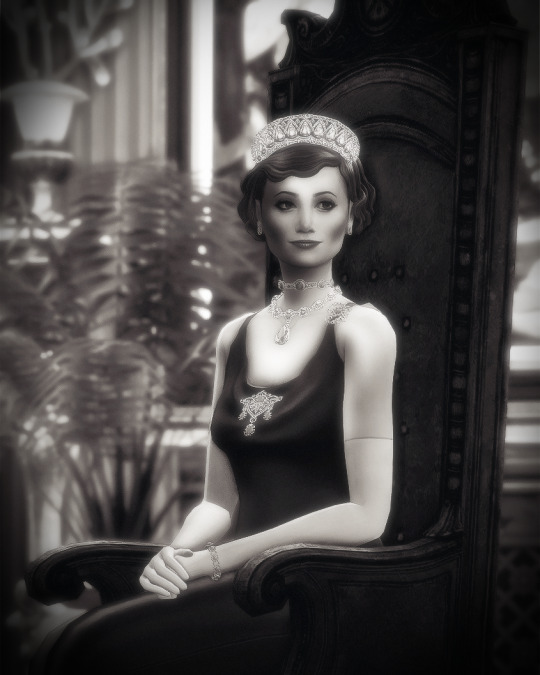
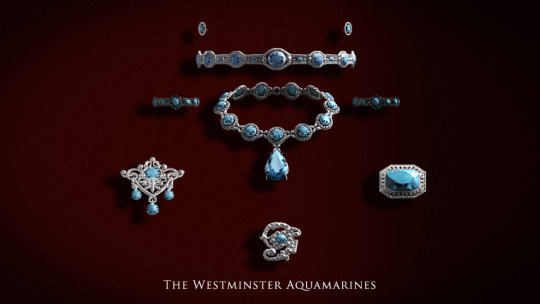
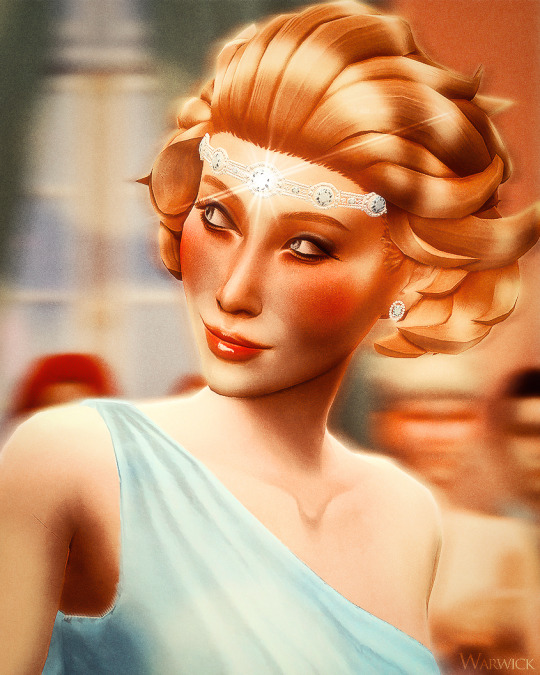

Sunderland's Royal Jewel Vault (27/∞) ♛
↬ The Westminster Aquamarines
The Sunderlandian royal family has several magnificent parures of aquamarine jewellery. One of these collections, the Westminster Aquamarines, features some of the royal family’s oldest and most iconic jewels; uncovering their history takes us back nearly two hundred years. In 1830s, Sunderland was a lone constitutional monarchy in North America, bordered by the United States in the northeast and Mexico to the southwest. The early 19th century had seen the country’s steady expansion westward thanks to territorial acquisitions from the Spanish and British. This period of territorial and economic growth, however, was cut short by the early death of Sunderland’s Hereditary Prince in 1835. Hereditary Prince Frederick James was just shy of thirty, the only son of King Louis III and his beloved first wife, Princess Amelia of the United Kingdom. Freddie was also the only legitimate male-line grandson of King Louis II, as a result, his death complicated Sunderland’s succession. The question of who would succeed Louis III ignited a fierce rivalry among the King’s younger brothers, as they scrambled to marry and produce an heir to the throne. The Duke of Lennox and St. George, the King’s first brother and heir presumptive, married an obscure German princess. The Duke of Glencairn, the King’s second brother, married the daughter of a wealthy British statesman. But it was the King’s fifth brother, Prince Augustus, the Duke of Westminster, who looked for a bride closer to home. Lady Martha Whitley was twenty years younger than her husband-to-be, a descendant of the Prussian nobility that migrated to Sunderland following the election of Prince Heinrich of Prussia as King Louis I of Sunderland, Martha hailed from one of Sunderland’s oldest aristocratic families. Unlike some of her foreign, and significantly younger, sisters-in-law Martha was shrewd and held a deep familiarity of Sunderland's court life, this was reflected in her impressive jewelry collection. On her wedding day, Martha was gifted a small box of aquamarine pendants of various shapes and sizes. As Martha’s prominence at court grew, the aquamarines became known as the Duchess of Westminster’s Aquamarines. Over the years, the Duchess incorporated the aquamarines into a few pieces of jewelry including a necklace and a pair of earrings. The tensions surrounding Sunderland’s succession died down when the British-born Prince George of Glencairn became king in 1860. By then Westminsters had three children, Prince Louis, who became Duke of Westminster following his father’s death in 1877; Prince Thomas, and Princess Elizabeth Anne. The family was popular with nobility and the public alike, but they weren’t without their scandals. After Prince Louis enraged King George by marrying without permission, his subsequent children were declared illegitimate and barred from inheritance. Finding a suitable wife for Prince Thomas, now heir to the Westminster Dukedom, became a top priority. In 1876, Prince Thomas met and fell in love with Princess Marie of Hanover, a male-line great-granddaughter of King George III and therefore a British princess. The couple married in 1880, but struggled to have children. In 1887, their only surviving child was born in the presence of Queen Alexandra. The little princess, given the lengthy name Alexandra Anne Martha Georgina Dagmar Gloriana Marie, would be known to history as Princess Anne of Westminster. Growing up, Anne was placed in the direct care of her Dear Granny Martha.
My grandmother was magnificent. She was kind but strict, with old-fashioned ideas about how a princess should be brought up. - Queen Anne of Sunderland, circa 1953
The Duchess of Westminster had high hopes for her only male-line granddaughter. Indeed, Anne’s maternal cousins were well-connected to the British and Danish royals, as well as the Imperial families of Russia and Germany. By the time Anne was twenty, she’d been taken on several trips to Europe, excursions she came to loathe. Anne’s anxiety worsened when she was rejected by several families. After her mother died in Austria, Anne returned from Europe “alone and feeling rather sorry for myself”. Back in Sunderland, Anne made friends with her second cousin once-removed, Prince George, the Duke of Woodbine and eldest son of the Prince and Princess of Danforth. Over the years, the pair’s friendship developed into a romance and in 1911, King George allowed the couple to marry. That same year, the Duchess of Westminster died, and Anne inherited the largest jewel collection in the royal vault, aquamarines included. Anne and George married in 1913. Anne, now Duchess of Woodbine, was one the most dynastically important ladies at court and she set to work reworking her grandmother’s jewels into spectacular works of art. For King George and Queen Alexandra’s 1920 Diamond Jubilee, Anne commissioned Garrard to work the aquamarines into a parure that included a necklace, a choker, two brooches, and a pair of earrings. The parure paired nicely with the aquamarine Georgiyevna Tiara, which entered the family in the early 1920s. To this day, the Georgiyevna aquamarines are often mistaken for those of the Westminster set, showing how ubiquitous they’ve become with the main-line royal family’s collection. When Anne became Queen in 1930, she wore the aquamarines. Despite her overflowing jewellery box, the aquamarines were evidently her favourite and became synonymous with her name and legacy. The Westminster aquamarines have remained iconic long after Queen Anne’s time. Queen Irene became another famous wearer of the suite, wearing the choker as both a necklace and a headband in the 1980s. Queen Anne was an important figure to Irene during the early years of her marriage, and she wears nearly all of the jewels her grandmother-in-law left to her. In the 2010s, Tatiana, then the Princess of Danforth was seen in bits and pieces of the suite, notably the choker, signalling that the jewels will be carried on into the next generation.
Queen Anne of Sunderland, wife of King George II, wears the Westminster aquamarines with the Georgiyevna tiara for a promotional image, circa 1930
Queen Irene of Sunderland, wearing a powder blue satin evening gown along with the Westminster aquamarine choker as a headband, attends a gala dinner on April 30, 1984 in Auckland, New Zealand
#warwick.jewels#✨#not a tiara technically i don't care leave me alone#ts4#ts4 story#ts4 royal#ts4 storytelling#ts4 edit#ts4 royal legacy#ts4 legacy#ts4 royalty#ts4 monarchy#ts4 screenshots
50 notes
·
View notes
Text
Hansdampf in allen Gassen
literally: Hans-Steam in every alley
an active, versatile and busy person, a Jack of all trades (with a rather negative connotation)
Origin: The phrase may have come from the fresh cake that was carried home steaming on St. John's Day after being baked in the bakery. The phrase Hans in allen Gassen appears in literature in the 1667 novel The Adventurous Simplicissimus by Hans Jakob Christoffel von Grimmelshausen (Book 2, Chapter 7). The extended expression Hans Dampf in allen Gassen was finally made widely known through the story of the same name by the German writer and Swiss citizen Heinrich Zschokke (1771-1848) from 1814. The main character in it is "Hans, the son of Mayor Peter Dampf", who combines the above-mentioned characteristics. Lutz Röhrich also writes that Hans Dampf was a real, well-known personality in Gotha in the 19th century.
16 notes
·
View notes
Text
Reasons why YOU should be suspicious of O'Connor
(contains spoilers to the princess event and slight Clarence's white day event) (it's also written from the prespective of an EN only player)
I believe O'Connor is in cahoots with Cael somehow and have alot of delusional reaching - that I and @smudgedvolt come up with in our secret lbc basement - to back me up
for one, he's the art TA for the school, and while Cael isn't the only art professor in the school, he was never specified to be anyone else's assistant, for all we know he may have been handpicked by Cael himself (i told you this had alot of delusional reaching)
he also just straight up didnt graduate, which is more of an indicator that Cael may have pulled some strings to get him to work in ST. Shelter

secondly, he's the only NPC that appears everywhere at all times on the map

he's the only NPC that does this as IL are the only ones that change location once per day, and NPCS like gerald and william are usually bound to where they are everyday
so how come he's the only one who can change location multiple times per day? and specifically going where YOU are?
what if he's specifically watching you?
he also gives MC alot of assignments,

Do you think he's maybe trying to keep her busy?
In his introduction, MC describes him as something that doesn't belong

it's not like its the first time she's seen tourists or older people at ST. Shelters?
later we learn that he was the council president, before he suddenly disappeared and came back unannounced

the only other people described by Clarence to have disappeared are MC and Cael and you obviously know what's up with them (this actually makes Clarence's relationship with MC a bit sadder bc this means he's used to people close to him like O'Connor suddenly disappearing without an explaination and this could be why he documented everything in his notebook)
and even if he didn't mean "fled" as in "disappeared", fled is still a strange choice of words, was he running away from something? someone?
he also seemed to know that she's missing points; he explains that, of course he knows as he was an art student as well, but would he be able to guess that she's behind all the other art students bc she missed a few activities?
unless he knew of her travelling to godheim at he start of the year

next is the list he made during princess event, i haven't played princess event myself though so forgive me if any of this is explained at some point but

he just??? made a list of all the paragons?? + william and two other guys??? lars ISN'T EVEN A STUDENT why on earth would he put him there??
after Heinrich's death, Clarence visited the lab to find it empty
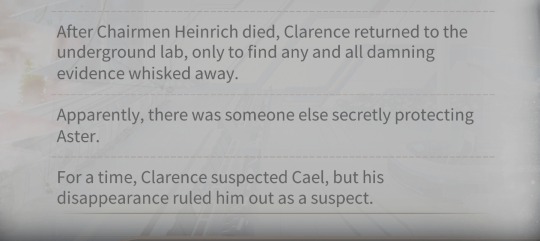
Clarence ruled out Cael because he also disappeared, although Cael has freaky time travelling powers but we cant rule out the possibility of someone else helping him
O'Connor is the only NPC with a card higher than R

i can't be the only one who finds it weird that Some Weird Art Guy™ just has an SR while lore important NPCS like Amelia and Naledi's counterparts are stuck as Rs and Ns?
I was gonna talk about this scene and the "mysterious seller"

but it all got thrown out of the window, it turns out Cael was behind the account :(
although I can technically use this along with other points to point out how william is even MORE suspicious than O'Connor but thats a post for another day
#crack theory#except I actually believe it#lbchronicles#lbc#lovebrush#lovebrush chronicles#lbc o'connor#lovebrush O'Connor#for all time otome#for all time#O'Connor
66 notes
·
View notes
Note
Why don't you have any detailed posts about Steuben smh do better
AW FUCK NO MY REPUTATION!! HOW AM I SUPPOSED TO BE THE GAY HISTORY PERSON IF I DONT HAVE A DETAILED POST ABOUT STEUBEN!!!! i have to fix this...
Early Life
Friedrich Wilhelm August Heinrich Ferdinand Baron de Steuben was born on September 17, 1730 in Prussia. He joined the Prussian army at the age of 17, so he got a real early start.
Note: I've written his name here as "Baron de Steuben", as this name is from a French record, however he is typically referred to as "Baron von Steuben", as "von" is the translation of "de" from French to Prussian, and they both mean "of" in English. I just wanted to clarify that for the sake of my own linguistically correct sanity
Steuben began his service in the French and Indian War (or Seven Years War if you're a dirty European) as a second lieutenant, and was then wounded at the Battle of Prague, a Prussian victory. Then, he joined General Johann von Mayer's adjutant and principle staff officer in a special detached corps.
Then, he was promoted to first lieutenant and wounded AGAIN at the Battle of Kunersdorf, which was a Russian and Austrian victory. He was then transferred to general headquarters as a staff officer in the position of deputy quartermaster (this is important!!).
He was taken prisoner when Major General von Knoblock surrendered at Treptow, and was released after a year in 1762. He was promoted to captain and then became an aide-de-camp to Frederick the Great, which is as metal as it gets. He joined the King's class on the art of war, where he learned even more super cool military leadership skills.
Life Between Wars
Steuben met St. Germain in Hamburg (a notoriously great place to meet people). If you aren't in the know like I clearly am, St. Germain would eventually be the French Minister of War during the American Revolution. They'd meet again in France when Steuben was serving as Grand Marshall to the Prince of Hollenzollern-Hechingen, and if that sounds made up to you, it's because you don't even know him like I do.
Steuben continued looking for military work, but those European assholes (the British, French, and Austrians) rejected my man for no good reason (probably because he was gay or something). It was during his stay in France where he heard of the rowdy Americans across the pond.
St. Germain introduced Baron von Steuben to Silas fucking Deane and Benjamin "Slim Shady" Franklin, but they weren't able to promise Steuben anything but some regurgitated American propaganda, since, by this time, they were already getting yelled at by Congress and Washington for allowing too many incompetent Frenchmen into the Continental Army. They told him that the only way he could assist in the American fight for independence would be to go to America and present himself as a volunteer to Congress (like Lafayette ended up having to do).
This obviously pissed off Steuben since he was actually experienced trying to get a job, because its not fun being an overqualified, unemployed gay man in 18th century Europe. But still, he settled for being a volunteer, and set out for America, his passage being paid for by the French government.
WHAT THE FUCK IS A KILOMETERRRRRRR
Steuben traveled to America with his Italian greyhound, Azor, and his two assistants, Louis de Pontiere (ADC) and Pierre Ettienne Duponceau (military secretary). They arrived in New Hampshire on December 1, 1777. They were almost arrested upon arrival because Steuben had a blond moment and mistakenly dressed them in red uniforms instead of blue. They traveled through Boston to York, Pennyslvania, arriving on February 5, 1778.
In Steuben's letter of recommendation, Franklin mistranslated Steuben's rank to "His Excellency, Lieutenant General von Steuben, Apostle of Frederick the Great", which made him seem way more distinguished than he was. As a result, he was presented a much higher rank by Congress.
Steuben was ordered to report to Washington's headquarters at Valley Forge, where he arrived on February 23, 1778, and was described by a soldier as "a perfect personification of Mars."
Steuben's good first impression also had an effect on Washington, who appointed him temporary Inspector General, and it was in this position that he had his largest impact on American history, and changed the course of the war
Why Every Army Should Have Gay People, An Essay by Publius
Baron von Steuben began his transformation of the Continental Army by writing training drills, overriding the regional trainings of the state militias into a unified and universal regimen. There was a significant language barrier, however, as Steuben originally wrote the drills in French, which were then translated into English by Duponceau, John Laurens, and Alexander Hamilton. Then, they were given to the brigade inspectors, who made the copies which were then copied to be delivered to each officer. There was definitely a more efficient way to do this, but you know. It was also Valley Forge.
General Washington's Life Guard and some men from each state (totalling around 120 men) were used as a model to show the rest of the army how they were supposed to go through the drills. As they trained and demonstrated the drills, Steuben was writing new ones, only a few days ahead, which is a massive time crunch. This was done intentionally to make the drills as simple as he could, so the training of the army was dispersed in a rapid, orderly fashion. This man was a genius, I can't emphasize it enough.
The officers in the British army, which was the standard for Americans in many respects, would allow the sergeants to drill the men, but Steuben said fuck that, I'm gonna do it myself. This made many American officers uncomfortable because the men developed a bond with him because of how talented he was (and the fact that he was funny and used profanity in multiple languages), and along with the fact that Steuben's office seemingly had no limitations, this caused them to complain to the big boss, Washington. To make them feel better, Washington issued orders on June 15, 1778 to govern the Inspector General's office until further word from Congress.
The reformed Continental Army showed off their swag on May 6, 1778 when they celebrated the news of the Franco-American Alliance, which impressed soldiers, officers, and civilians. More happy news came when Steuben was given his commission from the Congress as Inspector General, with the rank of Major General.
It was at the Battle of Monmouth when the new training of the Continental Army was able to take what would have been a losing battle for the Americans to a technical draw. Steuben was actually almost killed/taken prisoner (depending on the mood of the British) during this battle because he was wearing so many metals of honor that he glimmered in the sunlight, and was spotted by the British. He was fine, though.
General von Steuben went to Philadelphia in the winter of 1778-79 to write his book of regulations, referred to as The Blue Book. Lieutenant Colonel Francois de Fleury, a volunteer, assisted in writing it. It was with the assistance of ~Benjamin Walker~ and Duponceau that the blue book was translated into English, which is why we know Walker as being important! And the fact that he and Steuben totally boned! Anyway, Captain Pierre Charles L'Enfant was illustrated it, and the book was used all the way until 1814.
After the war
General von Steuben rejoined the Continental Army in April of 1779 to serve through the end of the war. He was an instructor and supply officer for General Nathanael Greene's southern army from the beginning of the southern campaign until Yorktown. Steuben commanded one of three divisions in the Continentals at Yorktown. He assisted in demobilizing the army in 1783, and resigned his commission in 1784, which is actually the latest I've heard of a Continental General resigning his commission!
Steuben continuously petitioned Congress for financial compensation for mesothelioma (not really) and fuck ass Congress only gave him a part of what he was owed, which was pretty typical. But! New York, Pennsylvania, and Virginia all gave him land grants, which he sold portions off to have enough money to live. So, he retired from NYC to his land holdings to live the remainder of his life.
Oh, and fun fact, Steuben was present at one of the riots in New York that Alexander Hamilton tried to stop, and they both had bricks thrown at them. It might have been the Cadaver Riots, but I could be wrong since I didn't feel like double checking.
Steuben never married, and instead lived with Benjamin Walker for a long period of time. He died on his 16,000 acre farm tract in the Mohawk Valley of New York on November 28, 1794.
Homosexuality
The source I used for this does not mention his homosexuality at all, but I'm going to, because the last thing you'll ever see me do is pretend like gay people didn't exist or are "unprofessional" to talk about in history.
If you say that Alexander Hamilton was gay, you have to say Steuben was, and vice versa. Rumors of homosexuality followed Steuben from Europe all the way to America, and play a large role in why he relocated many times, and never seemed to have a permanent home until the end of his life. This was a form of unofficial exile that many queer people faced in times where their existence was illegal. As soon as your name was associated with possible homosexuality, you couldn't get comfortable anywhere.
But von Steuben wasn't brought down by this, and you've gotta respect that. He threw elaborate parties starting almost as soon as he arrived at the Continental Army. If you're new to the amrev community here, this is what we mean by "flaming shot/pantless parties", because they had shots of liquor that they would light on fire, and in order to get in, at least part of your breeches had to have been missing. While straight men did attend these parties, the subtext in discussions about them seem to imply that they were also a gathering place for queer men.
These parties continued, and some familiar faces were there, such as Duponceau, Walker Hamilton, Laurens, and, later on, Charles Adams. However, I'm not going to speculate on who was fucking who, though it has been largely accepted by historians that General von Steuben and Benjamin Walker were lovers, and I personally think there is substantial evidence to support this when you align their personal correspondence with the close proximity they maintained throughout their lives.
General von Steuben is a figure that is very important to many queer people as a conspicuous queer man in history who had an undeniable impact on the course of American history. Portrayals of Steuben in media typically disregard this, however more and more biographers are discussing his homosexuality and the significance it plays in queer history. So, I'll end this post by saying this: Steuben is just as significant in American history as he is in Queer history, and it is irresponsible to pretend like he isn't.
Source:
National Park Service- Valley Forge
British Battles.com- Battle of Kunersdorf
George Washington's Indispensable Men by Arthur S. Lefkowitz
John Laurens and the American Revolution by Gregory D. Massey
Alexander Hamilton by Ron Chernow
Anyway, thank you for giving me an excuse to talk about Steuben lol. I didn't previously know much about his life before the American Revolution, so I was very happy to learn. I actually bought a biography about him not long ago, The Drillmaster of Valley Forge: The Baron de Steuben and the Making of the American Army by Paul Lockhart, but I haven't read it yet. If anyone has, pls let me know if it's good or not. After Massey and Chernow, I'm practically on my hands and knees begging for a male author to treat queer history seriously. Anyway, thank you for the ask! I'm going to go watch the george washington mini series for steuben content
#history#amrev#american history#asks#american revolution#18th century#1700s#alexander hamilton#john laurens#baron von steuben#general von steuben#steuben#fredrich wilhelm august heinrich ferdinand baron de steuben#queer history#live laugh gay people#french history#prussian history#french and indian war#seven years war#publius originals
28 notes
·
View notes
Text
Anyways not to take advantage of edward theories for the tedspiracy (i am tho) but every russian in st is an edward stand in. Like literally theyre all edward but its all ted related subtext so ppl dont catch on but. Its right there.
In the of Enzo/Dimitri its the most obvious. "Edward" literally means "wealthy *guard*". Dimitri is a prison guard. With a son named Mikhail (Michael). And a wife who Hopper calls a cheater. Not only that but his alias "Enzo"? Is a cognate of the name Henry (derived from the same name Heinrich- google will straight up tell you that Enzo is a cool exotic italian version of the English Henry to name your child. The two names have the same meaning: "home ruler").
Yuri is a doublet of George. Yuri has a daughter he buys gifts for (can anyone say hollys litebrite) and a helicopter he named after his "beautiful lover" Katinka, which you guessed it.... has the same meaning as Karen ("pure"). Again, a russian name but with the same meaning as the english counter part. He is also born in the same year as Ted which is even funnier.
And Alexei my beloved Alexei. "Defender" to Edward's "guard". So so funny that there also is a scientist named "Teddy" in HNL in s2. Nice comparison of the soviet government to HNL there.
Anyways what im saying is that the wheelers for some reason have Russian counterparts. I am also saying that hawkins is never beating the town full of lab rats actual matrix allegations if they keep on getting compared to surveillance state which was the soviet union. Insert here Ted asking if El is a russian in s1.... sir im pretty sure YOU are the russian but okay. What is your fuckign six figure job why are you being compared to a soviet scientist, guard, and smuggler. Something something russian spy fake family hysteria of the cold war. Is brenner your boss.
#anyways side note. this is how bauler can happen.#ted wheeler#henry creel#karen wheeler#martin brenner#mike wheeler
45 notes
·
View notes
Text
"Whispers of Love Amidst Mourning: The Intimate Union of Princess Alice and Prince Ludwig"🥀💗🖤

When that ill-fated year of 1861 came and the first misfortune for British royal family was the death of the Duchess of Kent, Queen Victoria’s mother, Prince Albert asked his Daughter Princess Alice to console her poor mother.
Then he himself felt so bad, suffering from stomach pains, and after he fell ill, Alice surrounded him with care and attention. But the prince still hoped to take part in the upcoming family holiday. After all, Alice now had a fiancé.💍🖇💗
The task of finding her future husband was once assigned to Her Older Sister Vicky, who had recently become the wife of the heir to the Prussian throne, actively got down to business.
The first candidate she selected was the Prince of Orange, the future king of Holland. The prospect of becoming a Dutch queen looked very tempting, but Princess Alice didn't like the proposed gentleman with lemon-yellow teeth.🤮🤢 The next contenders were two Hessian princes, Ludwig and Heinrich, who were invited to Windsor under the pretext of visiting the famous Ascot races.😍
The Princess immediately took a liking to the eldest of them, Ludwig, a pleasant and modest young man with a handsome appearance and while some of the spectators carefully watched the horses and riders fighting for the Royal Cup, and others assessed the outfits of the society ladies with no less interest, Alice and Ludwig cast meaningful glances at each other.
Before leaving, the prince asked Alice for a photograph as a souvenir, and she willingly gave it, trying with all her might to express her interest... Albert liked Ludwig too. Queen Victoria hesitated for some time. Still, the Duchy of Hesse-Darmstadt was a real backwater even by the standards of patchwork Germany.
But the German prince was so charming, so pleasant. He blushed so sweetly at every mention of Alice that the queen Victoria finally ceased to doubt the future happiness of her daughter.
Soon, together with her husband, Alice went to Coburg, Prince Albert’s homeland, stopping on the way to Darmstadt, where the princess was able to see and communicate with Ludwig again. The following spring, the young people got engaged. The plans were almost dashed by Albert's death on December 14, 1861... But Queen Victoria became unshakable in everything that concerned the wishes of her dear husband, and there was no question of postponing the marriage ceremony.
On July 1, Alice and Ludwig appeared before the altar erected in the banquet hall of Osborne House. There was nothing in the celebration that resembled the wedding of a royal daughter.
Alice remembered how her sister Vicky got married four years ago - a cortege of thirty carriages, seventeen representatives of the ruling houses of Germany, a luxurious ball in the Bikingham courtyard, where she pranced and sparkled, a whole thousand invited guests, a solemn service in St. James's Church, a rich dowry... Yeah, she was deprived of all this, but happiness lies in something completely different.
The bridesmaids struggled to put on a semblance of smiles... Heavy sighs were periodically heard from all sides... The Queen appeared in a black widow's outfit and almost immediately sank into a chair... She couldn't stand...
Next to her were her two sons, Edward, Prince of Wales, who tried to remain calm, and Alfred, who could not hold back his tears during the entire ceremony...💔💔💔🖤🖤🖤 "POOR AFFIE"
Alice entered arm in arm with her Paternal Uncle, Ernest of Saxe-Coburg, who acted as father of the bride... The embarrassed groom was afraid to look up. The altar was located under a large painting by F. Winterhalter depicting the royal family.
On the canvas at the feet of the happy parents, Victoria and Albert, their four children romped and played. An irrevocable past... The spiritual chants finally broke the queen’s self-control, and she burst into loud sobs.
Queen Victoria would later say that the day of this strange ceremony, which was more reminiscent of a funeral than a wedding, became one of the saddest in her life. However, neither she nor anyone else present could imagine what a truly ominous omen those gloomy circumstances would turn out to be for the fate of Alice and her offspring.💔
The “celebratory” dinner took place in the presence of only the newlyweds, the Queen and her youngest daughter Beatrice.
Ludwig received the highest English honor, the Order of the Garter.
Alice received as a gift from her mother a Bible, a gold bracelet with diamonds and pearls, and a dowry of 30 thousand pounds, hard-won through the Prime Minister.💎
In the evening she said that, having become Ludwig’s wife, she felt proud and happy.
“It’s like a dagger stabbed into my heart,” Queen Victoria comments on these words in a letter to her eldest daughter Vicky.😑
The newlyweds spent their honeymoon, which lasted only a week, nearby, on the same Isle of Wight, after which they went to Darmstadt, the capital of a small German duchy, where from now on they were to build a family life.
From the very border of Germany they were warmly greeted by local residents, and the meeting arranged in Darmstadt exceeded all expectations - Alice had never seen such enthusiasm and such cordiality addressed to her. Then everyday life began, dramatically changing the picture. Ludwig returned to military service, and his wife began to settle into her new surroundings. She soon noticed that, despite the initial delight, the residents of Darmstadt were very wary of her.
In her new homeland, Alice immediately became a stranger.
Englishwoman! Those around her showed distrust of the princess from such a distant, unusual and incomprehensible country, sometimes they grumbled and distorted her strange name in every possible way.
The tension was aggravated by the fact that persistent demands came from London to create suitable living conditions for the queen’s daughter.
But Ludwig's uncle, Grand Duke Ludwig III, did not have sufficient funds for such expenses.
And his nephew settled with his wife in the old parental home, in the mansion of Prince Charles.
Uncomfortable and overlooking a noisy street, it wasn't at suitable for creating a family “nest,” and Alice was very glad to leave on the eve of her first birth to England under the pretext of participating in the wedding of her older brother, the Prince of Wales.🤍
There, at Windsor Castle, on April 5, 1863, her daughter was born, named Victoria, in honor of her crowned grandmother... The girl was born on Easter Sunday, which added joy and gave hope for the final completion of all the recent sorrows that darkened the beginning of Alice’s independent life.✨️✨️✨️
Now the question of their own home for the young ducal family has become especially acute. Alice had no choice but to sacrifice almost her entire dowry for the construction of a new palace in Darmstadt, the construction of which would take two years. The project was based on the princess’s favorite castle in Osborne, the home of her happy childhood, the home of her bright memories. In the meantime, the addition of the family became the reason for the forced gift from the Grand Duke. Ludwig III gave his nephew Kranichstein one of his hunting houses six kilometers from the city.
Alice will rebuild the modest estate, loudly called a castle, to her own taste, ultimately obtaining a long-awaited corner for a quiet family life. From now on, the young Duke’s family will spend the warm season here. The house was just being settled when the owners had to receive guests of the highest level...🌺
Russian Emperor Alexander II came to Darmstadt with his wife and younger children. This was not surprising - Empress Maria Alexandrovna was a born Hessian princess and often visited her homeland. Ludwig III and Prince Charles were her siblings, whom she was always glad to meet...
This time, the Empress decided to visit her nephew Ludwig to get to know his own family, for which the Royal Family went to Kranichstein, where a real fuss arose in connection with this.
Princess Alice, who always remembered that she was the daughter of the Queen of England, didn't want to lose face and worked with all her might.❤️🔥
From the words of her husband, who visited Moscow for the coronation of Alexander II, she knew about the unheard-of luxury that surrounded the Russian Tsar and about the strictest etiquette imphis presence.❤️🇷🇺
There was a lot to worry about, but to the surprise of the hosts, the distinguished guests turned out to be nice and kind people... Instead of stiffness, they showed kindness and ease; instead of Asian barbarism, they showed great intelligence and subtle taste.
And how charming their children are! Smart, well-mannered. especially admired Grand Duke Sergei, in whom even little Victoria felt something good and attractive. She constantly smiled at this boy, asked to see him and did not want to part with him.
It's said that Alice, who was then in the last months of a new pregnancy, let Little Grand Duke Sergei listen to how the heart of the expected child was beating inside her. A touching story💗💗💗 and the Grand Duke in such an unusual way “met” (who would have thought!) with his future wife even before her birth!💗💗💗
28 notes
·
View notes